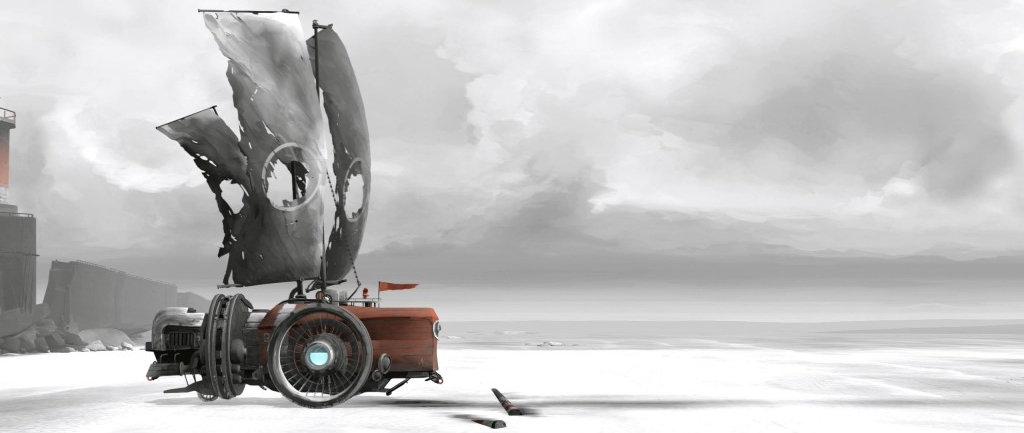I am … a leaf on the wind.
I am … a survivor, trekking the great unknown.
I am … an alchemist, transforming scraps into fuel, breathing life into rusted wheels and wind-torn sails.
I am … playing Far: Lone Sails, an adventure-experience video game set in the desolate wasteland of a post-apocalyptic society and I am more at peace than I have been in a long time.
It’s an odd realization anyone who comes to the game – which first dropped two years ago and has since enjoyed a kind of cult following with fans praising greyscale aesthetic and ambiguous storytelling – might have within the first 10 minutes of play. You’ve met your character – a minuscule mechanic in a red hat and poncho – as she bids farewell to a marked grave. Is it her father’s? Her brother’s? Her mentor’s? You’ll never know. In fact, you won’t understand much about this world – how its oceans dried up, leaving the bones of tankards and cruise ships cemented in muddy bedrock, what happened to its inhabitants, where its wildlife went, or why you seem to be the lone survivor on this barren planet equipped with broken down steampunk ship you’re meant to sail across the dusty seas.
That unknowing, strangely enough, is part of the appeal.
In an era where every RP video game character has a story, where every multi-player world comes scripted with mythological explanations and prescribed destinies, Far: Lone Sails commits itself to an often-ignored adage: it’s not the destination, but the journey.
And this journey is one you probably haven’t taken before – at least not in video game form.
For starters, you’ll finish it in three to four hours, perhaps earlier if you’re blessed with basic coordination skills and a rudimentary understanding of machinery. If not, the gameplay asks you to trust your intuition and pay attention to the various signals and gauges on your ship. You’ll find her after sifting through the wreckage of your old life, carting mailboxes and suitcases, and lanterns on your journey to your metal mobile home.
Once inside, you’ll discover various buttons meant to work everything from the engine to the fuel dump to, eventually, the shredded sails that usher you along a monotoned landscape (the kind Denis Villeneuve would be envious of) if you happen to run out of energy boxes. This is the closest thing to a relationship with a living being you’ll have in the game and yet, somehow, I felt a deeper sense of connection to this hunk of scrap metal than I have to any character, in any other game I’ve played this year.
That’s the point of Lone Sails. There aren’t sweeping battlefields or multi-player arenas to navigate. You won’t find the same high-stakes action of a Darkest Dungeon or the constant pressure of survival odds like in Don’t Starve. Instead, your objective is to keep your rickety ship rolling – feeding it boxes of fuel when the gauge runs low, putting out electrical fires, fixing mechanical mishaps, and giving it upgrades like sets of sails, when you can.
And your reward? It’s even less obvious. You don’t rake up points or lives or coins. You don’t collect cool gear or trade in for the latest skins. You simply live. And work. And push through the various elements outside of your control – the quickly-building storms and violently-erupting volcanoes, the impassable waters and blocked bridges – solving puzzles and finding solutions so that you can keep moving forward.
It might read as a metaphor for life, if we wanted to ascribe that kind of heavy, philosophical thinking to a game whose basic controls only let you move right, left, and up. Some fans have interpreted the muted gameplay as symbolic of a journey from life – the first spark of your engine – to death, when you reach an unknown, unconquerable shore. Maybe it is, maybe it isn’t, but its that gift of immersion that feels like the game’s strongest trait.
That, and its soundtrack which is filled with everything from symphonic melodies that swell as you hoist your sails to the pitter of your character’s feet as she scurries across the desert searching for supplies. In the lulls between, when you’re hunting puzzle clues or organizing your cargo, quiet notes spring from a piano, drowned out by whistling gusts of wind. It’s solitary, almost hauntingly lonely, and weirdly calming.
Nearly all of the games rising through the ranks this year have been socially-oriented – think of the murder-mysteries like Among Us or the neon-painted gladiator arenas of Fall Guys. Maybe that’s why the opportunity to just exist by yourself in the world of Far: Lone Sails feels kind of revolutionary.
Whether you reach your destination or not is entirely dependent on you and how well you look after your ship – this unfeeling automaton that thrives or dies based on your choices. I’ve never understood the bond between man and machine. Maybe you haven’t either. But you’ll leave this game with an attachment to this dependent, vulnerable vessel that rivals the love Nathan Fillion’s character in Firefly had for his space-traversing pirate ship, Serenity.
Far: Lone Sails is both expansive and contained, nail-bitingly nerve-wracking (especially if you pay an unwarranted amount of attention to your ever-dwindling fuel tank) and entrancingly tranquil. It imagines an apocalypse free of zombie-hordes, deadly-viruses, and people, and somehow, still crafts genuine emotional connection, the kind of weighty stakes that might leave you quietly sobbing by the end. It’s the most peaceful Armageddon I’ve ever seen – on any screen – and I wish there were more games like it.

